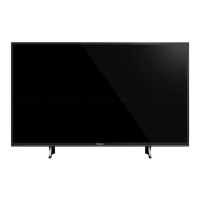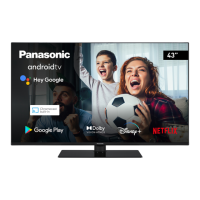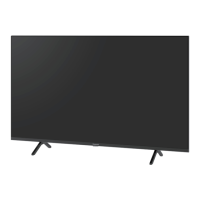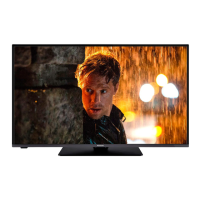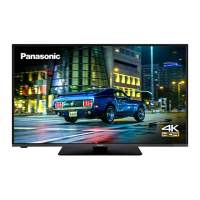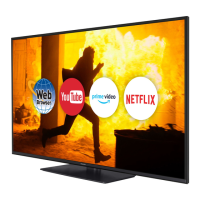Do you have a question about the Panasonic TX-43FX550B and is the answer not in the manual?
Covers CAUTION boxes for electrical shock and opening the unit.
Mandatory instructions to read before installing or operating the device.
Explanation of symbols used on the product for safety.
Information on Class II equipment, functional earthing, and live terminals.
Precautions regarding coin/button cell battery ingestion hazards.
Warnings about battery exposure to heat and potential hazards.
Guidelines for safely placing the TV to prevent falls and injuries.
Precautions for safely mounting the TV and using wall brackets.
Instructions for cleaning the display panel, cabinet, and pedestal.
Guidance on cleaning the mains plug to prevent fire or shock.
Steps for assembling and removing the TV's pedestal.
Details on hole positions for wall-hanging bracket installation.
Specifications for screws used in wall bracket installation.
Tips for reducing energy consumption using TV settings.
List of primary features including digital TV, HDMI, USB, and more.
Information on High Dynamic Range and Hybrid Log-Gamma support.
Explanation of the Auto TV OFF function and its settings.
How to use the TV's built-in joystick for control.
Basic navigation using the Home button on the remote.
Switching between different input sources.
Adjusting volume and changing channels with remote buttons.
How to add, delete, or move items in the Home menu.
Accessing Guide, Channels, and Timers from the TV menu.
Navigating to the TV's main settings menu.
Accessing and managing installed TV applications.
Overview of managing connected input sources.
Editing source names and enabling/disabling options.
Explanation of the battery symbol and its chemical context.
Details on TV broadcasting standards and channel reception.
Specifications for voltage, power consumption, and operating environment.
Information on TV weight, dimensions, and display characteristics.
Details on audio output power and headphone specifications.
Restrictions for using wireless LAN in different countries.
Information on DVB-T/T2 and DVB-C standards and compatibility.
Buttons for controlling power, volume, and mute functions.
Buttons for menu navigation, channel selection, and source input.
Buttons for controlling media playback like play, pause, stop.
Buttons to access Guide, Netflix, and Freeview Play.
Buttons for custom functions (My Button 1) and information display.
Details on VGA, AV, Component, and Audio input connections.
Information on Optical Audio Output (SPDIF) and Ethernet (LAN) ports.
Details on USB ports and the Common Interface (CI) slot.
Steps for selecting language and country during initial setup.
Choosing between Store Mode and Home Mode for TV operation.
Setting privacy preferences for smart TV applications.
Configuring wired or wireless network connections.
Enabling or disabling the Wake On feature.
Agreeing to terms for using Freeview Play services.
Selecting broadcast types and tuning channels.
Important warning about backing up data before connecting USB devices.
Navigating and using the Media Browser menu.
Details on loop and shuffle playback modes.
Using ARC for audio output to external systems.
Settings for Mode, Contrast, Brightness, Sharpness, and Colour.
Controls for energy saving modes and backlight level.
Enhancements like Dynamic Contrast, Noise Reduction, and Colour Temp.
Adjustments for picture position, dot clock, and phase in PC mode.
Adjusting volume, equalizer, and speaker balance.
Managing headphone volume, sound modes, and lineout settings.
Settings for network type, scanning, speed test, and advanced options.
Procedures for automatic, manual, and network channel scanning.
Fine-tuning analogue channels, clearing lists, and managing settings.
Settings for language, privacy, parental controls, and date/time.
Managing sources, accessibility features, and audio description.
Managing apps, HbbTV, software updates, and auto standby.
Configuration for power-up modes and virtual remote features.
CEC functionality, auto power on, and speaker output selection.
Management of cookies and display of open source software licenses.
Editing channel lists and managing favourite channel lists.
Setting up parental locks, PINs, and guidance settings.
Overview of the Electronic Programme Guide functionality.
Switching between Timeline Schedule and Now/Next views.
Selecting channels, viewing event details, and setting timers from EPG.
Using digital teletext and MHEG teletext modes.
Accessing BBC Red Button+ interactive services.
Performing manual and automatic software searches.
Resolving problems with TV power, picture quality, and sound.
Troubleshooting remote control malfunctions and no signal errors.
Compatibility of Analog AV and HDMI signals with the TV.
List of supported video codecs, containers, and picture file types.
List of supported audio codecs and their sample rates/bit rates.
Supported formats for internal and external subtitle files.
Steps for connecting the TV to a wired network.
Steps to connect the TV to a wireless network.
Setting up wireless network parameters and security.
Using WPS for easy wireless network connection.
Information regarding customer data handling for internet services.
Enabling and using the Wake On feature for network wake-up.
Troubleshooting common problems with wireless network connectivity.
Resolving internet connection and Audio Video Sharing problems.
Steps to set up and use the Audio Video Sharing service.
Accessing, managing, and adding new applications to the TV.
Conditions necessary for using Freeview Play services.
How to interact with HbbTV applications using remote keys.
Instructions on how to enable or disable the HbbTV feature.
Guidelines for connecting the TV to the mains power supply.
Correct wiring procedure for the mains lead based on wire colors.
Safety precautions to prevent electric shock, especially when opening the unit.
General safety advice for equipment handling and usage.
Covers CAUTION boxes for electrical shock and opening the unit.
Mandatory instructions to read before installing or operating the device.
Explanation of symbols used on the product for safety.
Information on Class II equipment, functional earthing, and live terminals.
Precautions regarding coin/button cell battery ingestion hazards.
Warnings about battery exposure to heat and potential hazards.
Guidelines for safely placing the TV to prevent falls and injuries.
Precautions for safely mounting the TV and using wall brackets.
Instructions for cleaning the display panel, cabinet, and pedestal.
Guidance on cleaning the mains plug to prevent fire or shock.
Steps for assembling and removing the TV's pedestal.
Details on hole positions for wall-hanging bracket installation.
Specifications for screws used in wall bracket installation.
Tips for reducing energy consumption using TV settings.
List of primary features including digital TV, HDMI, USB, and more.
Information on High Dynamic Range and Hybrid Log-Gamma support.
Explanation of the Auto TV OFF function and its settings.
How to use the TV's built-in joystick for control.
Basic navigation using the Home button on the remote.
Switching between different input sources.
Adjusting volume and changing channels with remote buttons.
How to add, delete, or move items in the Home menu.
Accessing Guide, Channels, and Timers from the TV menu.
Navigating to the TV's main settings menu.
Accessing and managing installed TV applications.
Overview of managing connected input sources.
Editing source names and enabling/disabling options.
Explanation of the battery symbol and its chemical context.
Details on TV broadcasting standards and channel reception.
Specifications for voltage, power consumption, and operating environment.
Information on TV weight, dimensions, and display characteristics.
Details on audio output power and headphone specifications.
Restrictions for using wireless LAN in different countries.
Information on DVB-T/T2 and DVB-C standards and compatibility.
Buttons for controlling power, volume, and mute functions.
Buttons for menu navigation, channel selection, and source input.
Buttons for controlling media playback like play, pause, stop.
Buttons to access Guide, Netflix, and Freeview Play.
Buttons for custom functions (My Button 1) and information display.
Details on VGA, AV, Component, and Audio input connections.
Information on Optical Audio Output (SPDIF) and Ethernet (LAN) ports.
Details on USB ports and the Common Interface (CI) slot.
Steps for selecting language and country during initial setup.
Choosing between Store Mode and Home Mode for TV operation.
Setting privacy preferences for smart TV applications.
Configuring wired or wireless network connections.
Enabling or disabling the Wake On feature.
Agreeing to terms for using Freeview Play services.
Selecting broadcast types and tuning channels.
Important warning about backing up data before connecting USB devices.
Navigating and using the Media Browser menu.
Details on loop and shuffle playback modes.
Using ARC for audio output to external systems.
Settings for Mode, Contrast, Brightness, Sharpness, and Colour.
Controls for energy saving modes and backlight level.
Enhancements like Dynamic Contrast, Noise Reduction, and Colour Temp.
Adjustments for picture position, dot clock, and phase in PC mode.
Adjusting volume, equalizer, and speaker balance.
Managing headphone volume, sound modes, and lineout settings.
Settings for network type, scanning, speed test, and advanced options.
Procedures for automatic, manual, and network channel scanning.
Fine-tuning analogue channels, clearing lists, and managing settings.
Settings for language, privacy, parental controls, and date/time.
Managing sources, accessibility features, and audio description.
Managing apps, HbbTV, software updates, and auto standby.
Configuration for power-up modes and virtual remote features.
CEC functionality, auto power on, and speaker output selection.
Management of cookies and display of open source software licenses.
Editing channel lists and managing favourite channel lists.
Setting up parental locks, PINs, and guidance settings.
Overview of the Electronic Programme Guide functionality.
Switching between Timeline Schedule and Now/Next views.
Selecting channels, viewing event details, and setting timers from EPG.
Using digital teletext and MHEG teletext modes.
Accessing BBC Red Button+ interactive services.
Performing manual and automatic software searches.
Resolving problems with TV power, picture quality, and sound.
Troubleshooting remote control malfunctions and no signal errors.
Compatibility of Analog AV and HDMI signals with the TV.
List of supported video codecs, containers, and picture file types.
List of supported audio codecs and their sample rates/bit rates.
Supported formats for internal and external subtitle files.
Steps for connecting the TV to a wired network.
Steps to connect the TV to a wireless network.
Setting up wireless network parameters and security.
Using WPS for easy wireless network connection.
Information regarding customer data handling for internet services.
Enabling and using the Wake On feature for network wake-up.
Troubleshooting common problems with wireless network connectivity.
Resolving internet connection and Audio Video Sharing problems.
Steps to set up and use the Audio Video Sharing service.
Accessing, managing, and adding new applications to the TV.
Conditions necessary for using Freeview Play services.
How to interact with HbbTV applications using remote keys.
Instructions on how to enable or disable the HbbTV feature.
Guidelines for connecting the TV to the mains power supply.
Correct wiring procedure for the mains lead based on wire colors.
Safety precautions to prevent electric shock, especially when opening the unit.
General safety advice for equipment handling and usage.
| Screen Size | 43 inches |
|---|---|
| Display Technology | LED |
| Smart TV | Yes |
| HDMI Ports | 3 |
| USB Ports | 2 |
| Wi-Fi | Yes |
| Ethernet | Yes |
| Audio Output | 20W |
| Weight | 9.5 kg |
| Bluetooth | No |
| Resolution | 3840 x 2160 (4K Ultra HD) |
| HDR Support | Yes (HDR10, HLG) |


